I wanna ride on abroad.
Honolulu Century Ride 2023 Chronicle
#5 Ride! Honolulu Century Ride !
I never imagined that a day like this would come in my life. Being invited as a guest rider for the Honolulu Century Ride (HCR), which boasts a 40-year history, is quite an honor. And the fact that this ride will be professionally recorded for a television program adds another level of excitement.
Up to this point, I’ve been writing about shipping my bike from Japan, my first impressions of Hawaii, and the test ride in Hawaii. Now, it’s time for the actual HCR event.
The night before the ride, I couldn’t quite settle my nerves. I didn’t want to eat too heavily, as it might make me feel sluggish, so I had sushi rolls and a vegetable salad I bought from the ABC Store, eating it quietly in my hotel room.
Before going to bed, I prepared my cycling gear and packed a puncture repair kit. The bib number I received for this ride is 40. It’s an honor to wear this bib for the 40th Honolulu Century Ride. Thinking about that, I went to bed with excitement, much like a child on the eve of a school excursion.
Little did I know that the next day would bring an unexpected accident during the main event, but of course, at this point, I was completely unaware of what lay ahead.

The next morning, I left the hotel a little after 5 AM to head to the starting point by bike. It was still dark as dawn was breaking, and the roads were dimly lit. As I got closer, I noticed more cyclists on the road.
Upon arriving at the meeting point with the producer, Mr. Watanabe, I saw that the photographers and videographers, who would be capturing the event, were getting ready. Mr. Kitagawa was going to ride alongside us on a yellow tricycle.



This time, I started with the front group. To avoid the crowds, I had my picture taken with my number 40 bib in front of the starting gate before it got too busy.
As the starting time drew nearer, Mr. Kitagawa, the photographer, began taking photos. I’ve mentioned it several times, but it’s hard to believe that a guy in his 50s has a chance of making a significant mark in this challenge. But that’s not something I should be pondering. Instead, I aimed my iPhone at Mr. Kitagawa as he pointed his camera.
This year, there were around 1,300 riders participating in the HCR. About 350 of them were from Japan. Gradually, the roads filled with bikes. Anticipation and excitement blended together, and the atmosphere heated up. I love this moment.
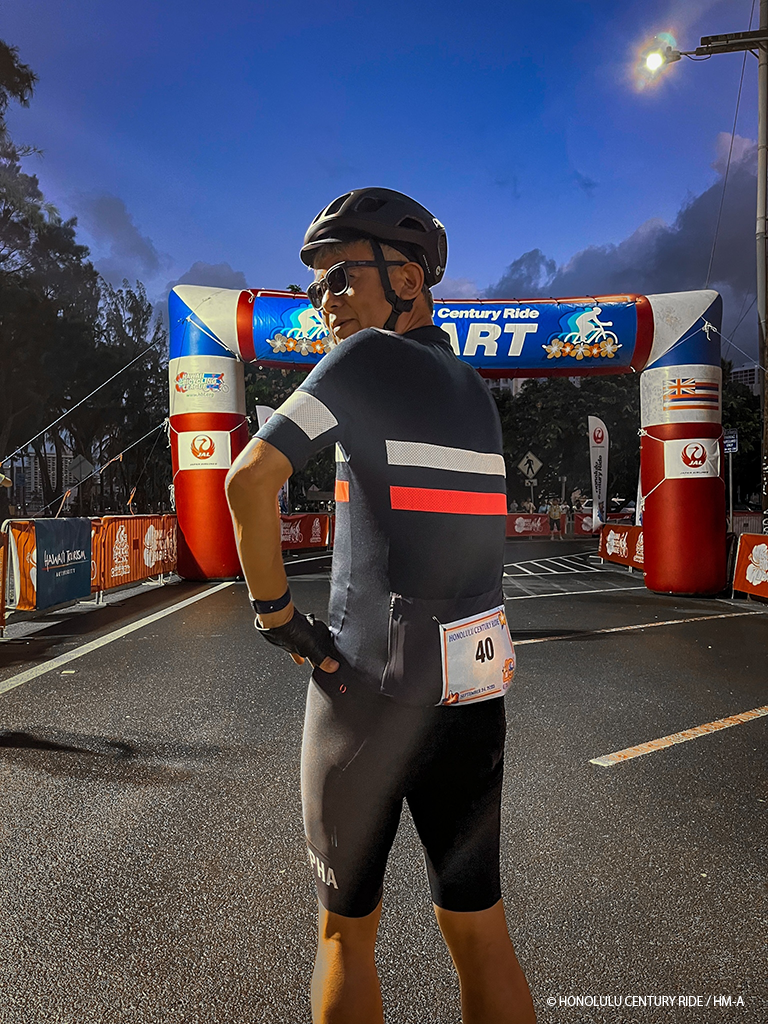

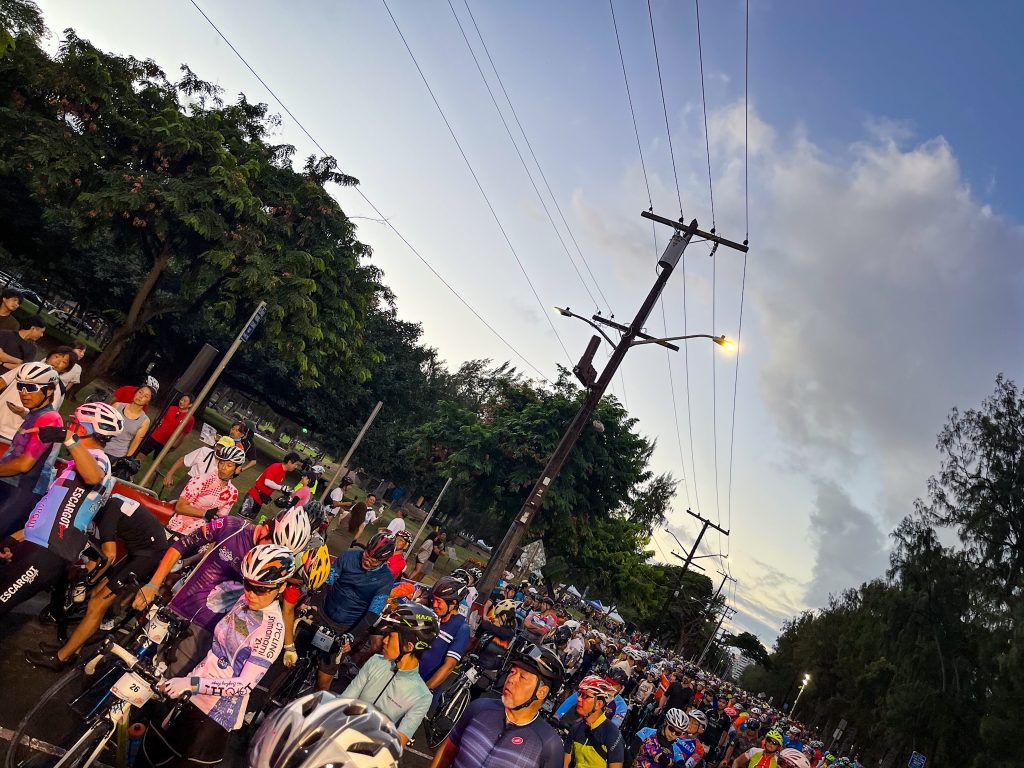
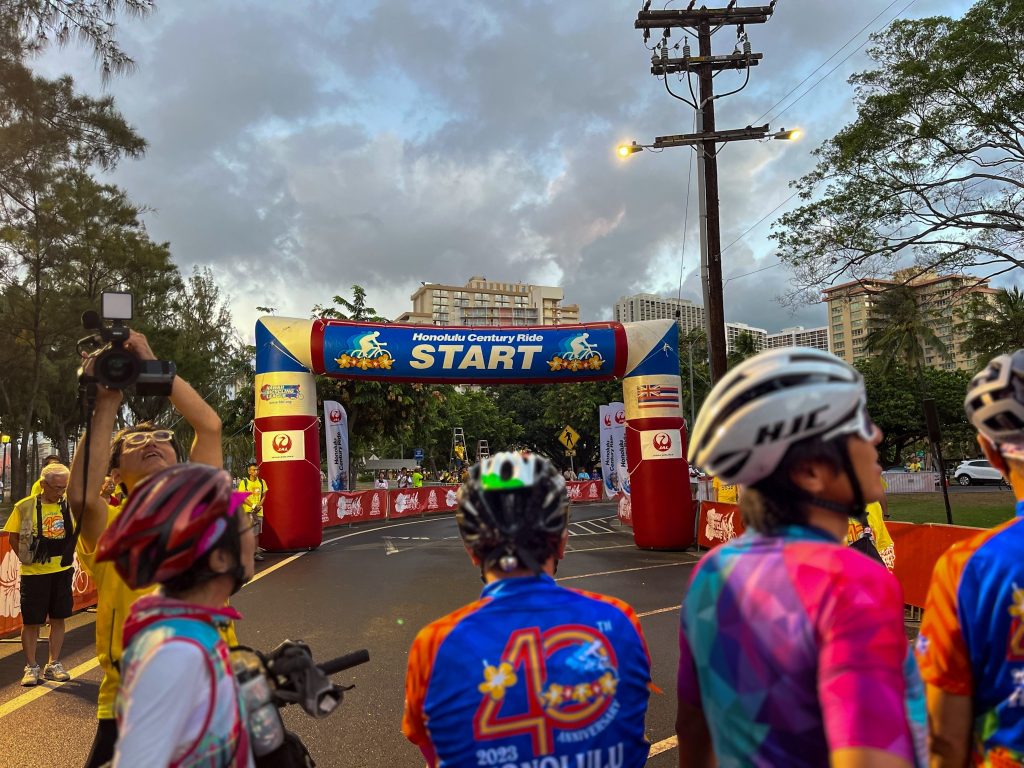
With the dawn, the starting flag was waved.
Riders set out one by one for the long journey of 160 km. I pedaled alongside this group. The sun was rising moment by moment, painting the eastern sky a burning shade of orange.
To complete the HCR, I had made up my mind about one thing.
In the beginning, I wouldn’t push myself too hard.
160 km is quite a distance. If you exhaust your legs in the first half, the second half becomes much tougher. I usually tend to push hard to keep up with the front group, but this time, I resisted that urge. I told myself to take it easy, enjoy the scenery, and savor the ride.
As I left Waikiki behind and circled Diamond Head, I approached the first Lookout point. I stopped my bike and gazed out at the sea. The sun was painting everyone and everything in golden hues. Its beauty captivated me.
I spotted a familiar face, the legendary figure of the Japanese road racing world, Daisuke Imanaka. He was the first Japanese to participate in the Tour de France and a superstar who leads the road bike brand called Intermax. Liberated by the feeling of being abroad, I couldn’t resist calling out to him. I had once shared a radio program with his younger brother. From there, I started a rapid-fire introduction of myself, explaining that I used to work as a producer at NHK and host a program called “Totsugeki KANEO-kun.” Imanaka smiled and listened to my enthusiastic talk.
Producer Watanabe, who was watching this, then greeted Imanaka, saying it had been a while. They had worked together on a program in the past. Watanabe truly knows many people.
Taking advantage of this rare opportunity, I asked Imanaka if we could take a photo together. The two of us, framed by the morning sunrise in Hawaii, would be my cherished treasure.
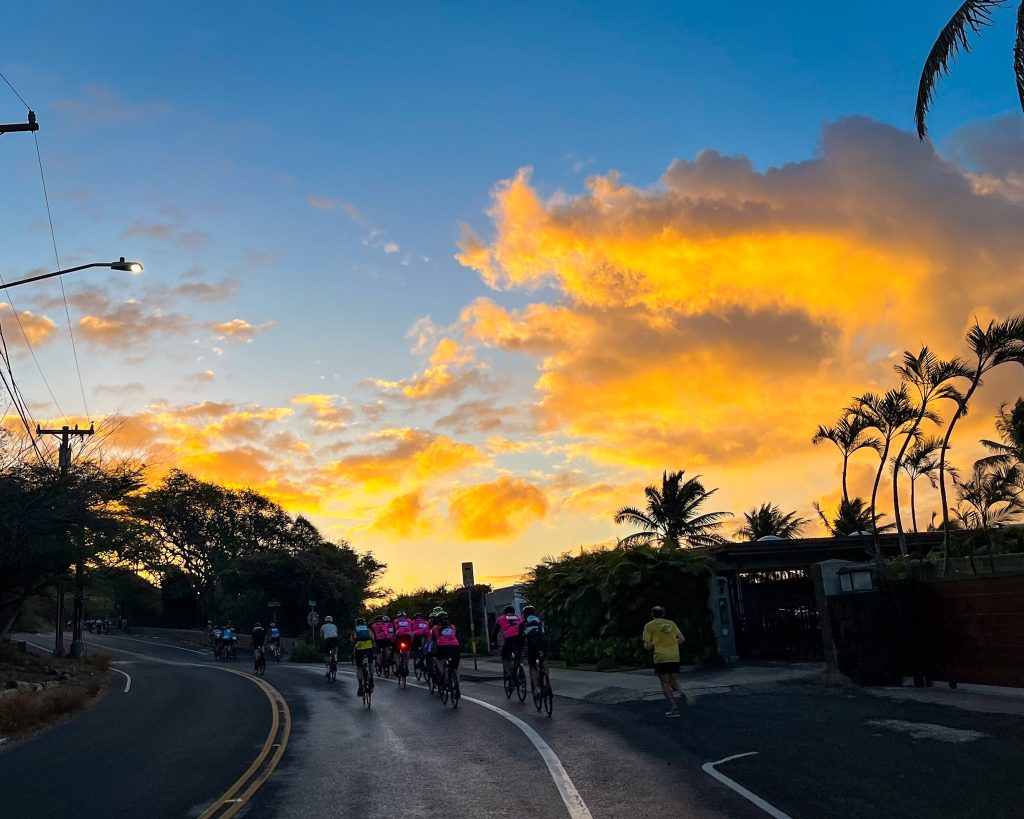


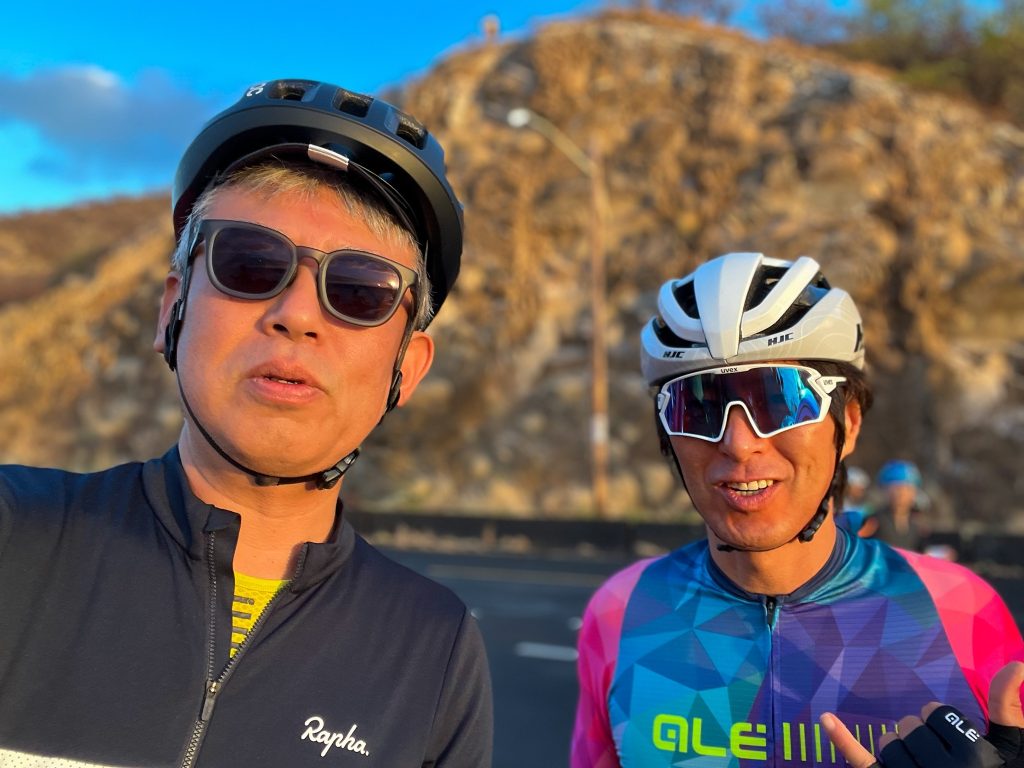
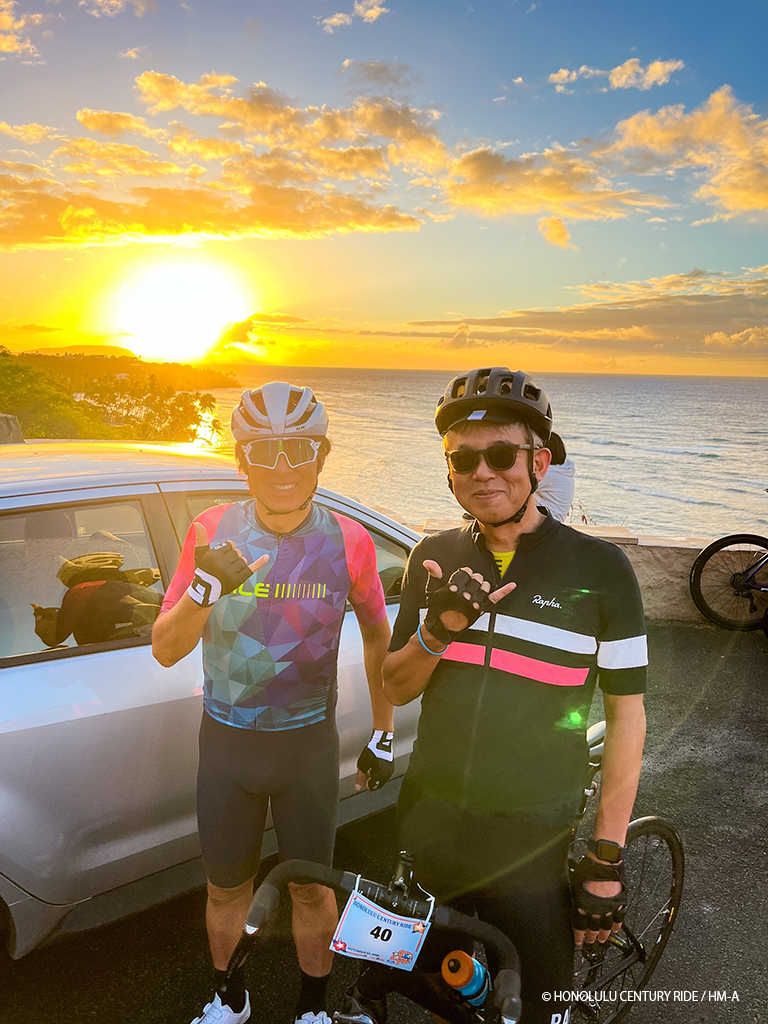
The sky grew brighter, and the temperature began to rise. As we passed through the highway, a long incline came into view. Riders started to slow down and bunched up in a group as they tackled the ascent. The gradient wasn’t particularly steep, but it was a long, gradual climb. I switched to a lower gear, pedaling steadily as I made my way up.
During the COVID-19 pandemic, fan rides within Japan were almost impossible to organize. Being able to ride with cyclists from all around the world felt like a dream come true.
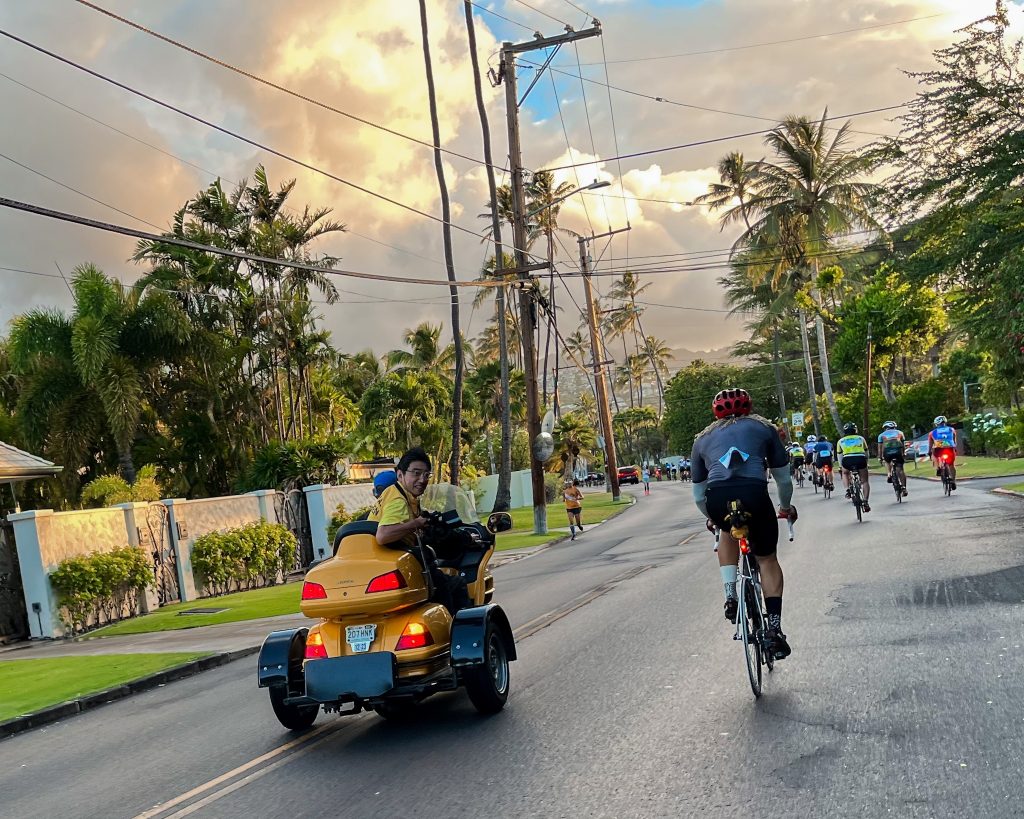
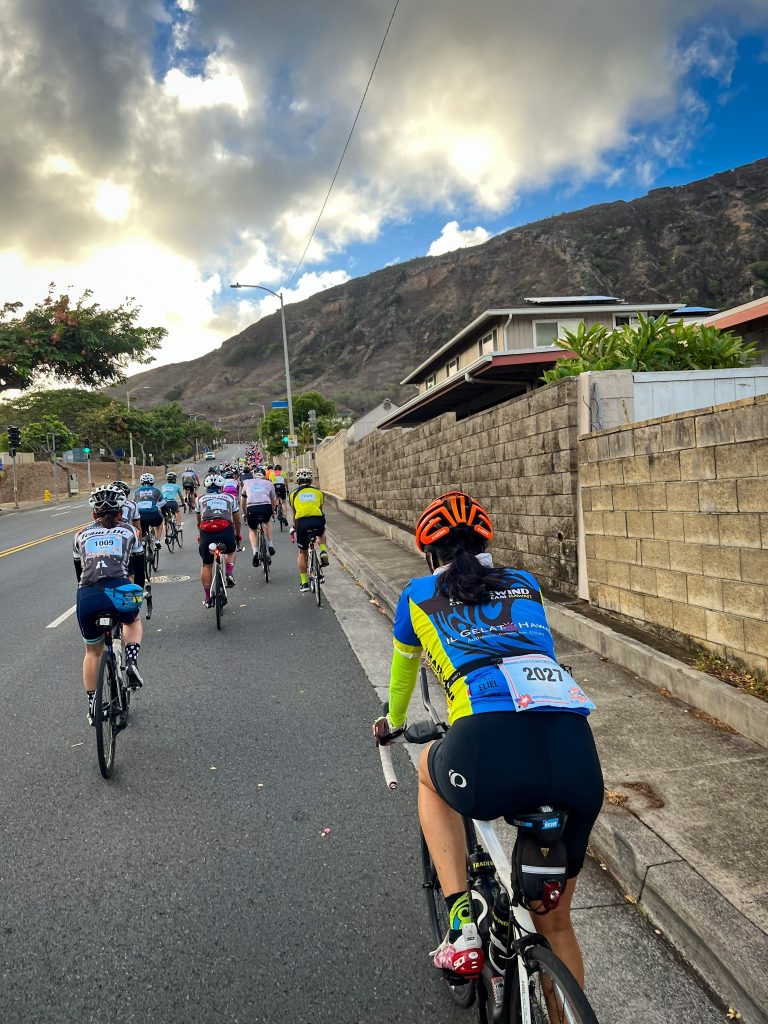
After about an hour of riding, I reached the first aid station, located at Sandy Beach Park, which was around 20 kilometers into the ride. They were serving a large quantity of donuts here. These were handmade, large donuts, cut into two or three pieces, and they had purple yam in them, giving them a slightly purplish color. As you took a bite, you could taste the sweetness of the sugar. Since my breakfast had been somewhat modest, I ended up devouring three of these donuts.
Of course, you could also refill your water at every aid station. The dry Hawaiian air made your water bottles empty quickly. I filled my bottles with nice, cold water and got back on the course.
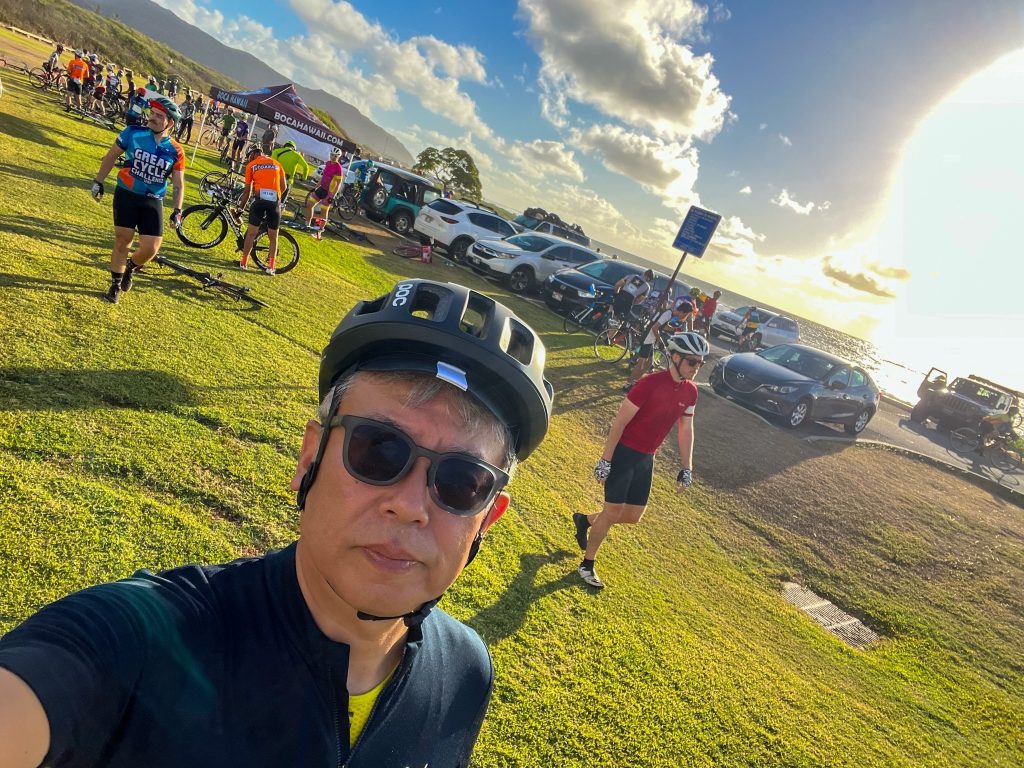
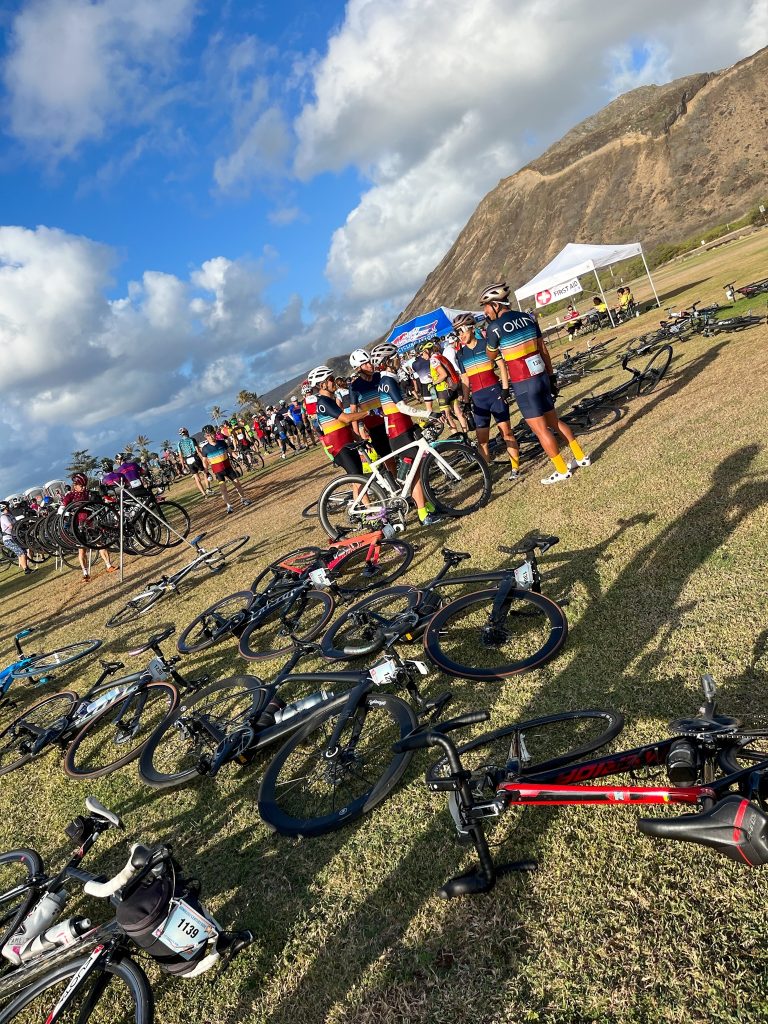

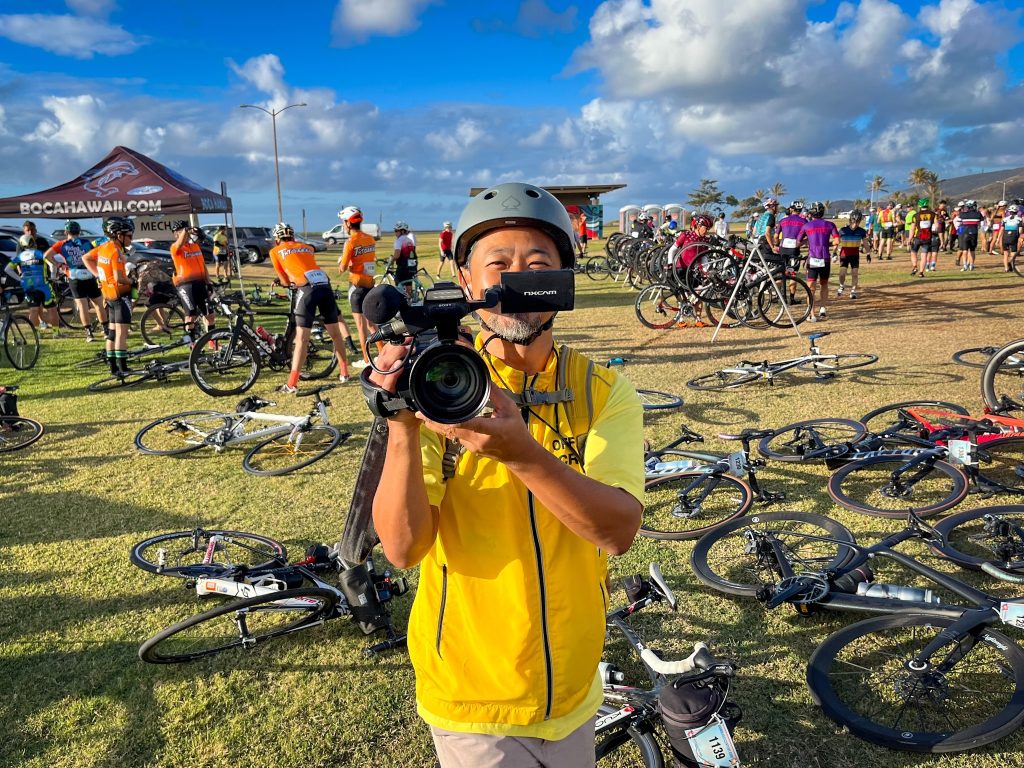
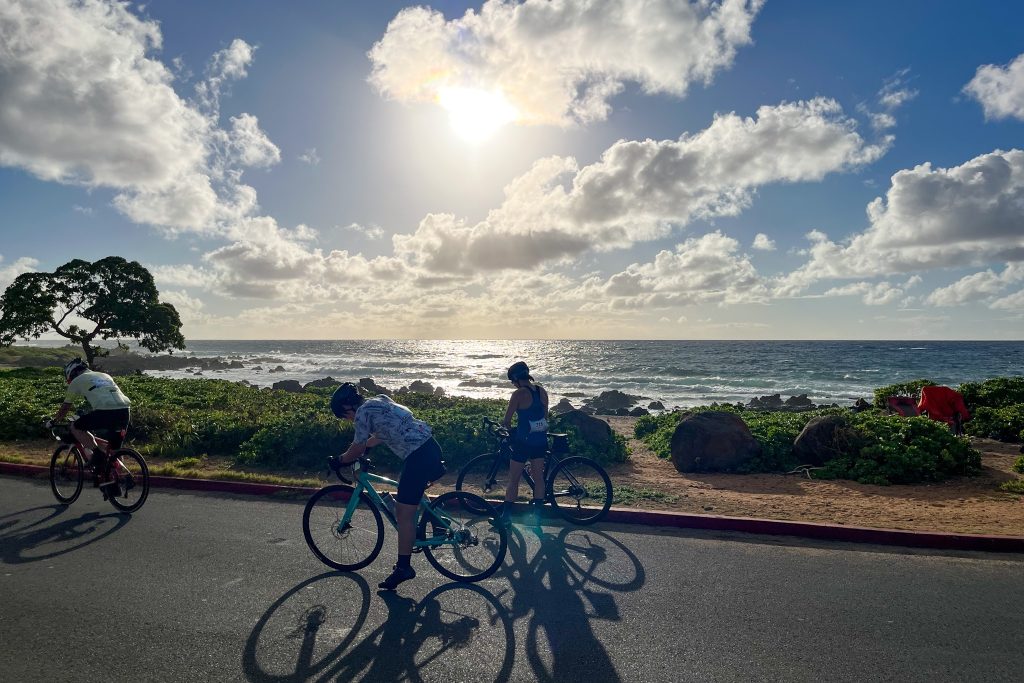
By the time I reached Makapuu Point, one of the top scenic spots on the Honolulu Century Ride, the sky had brightened completely, and the sea displayed beautiful gradients. Here, I ran into legend Mr. Imanaka again. Without hesitation, I asked for another photo. Hawaii is amazing; my collection of cherished treasures is growing rapidly.

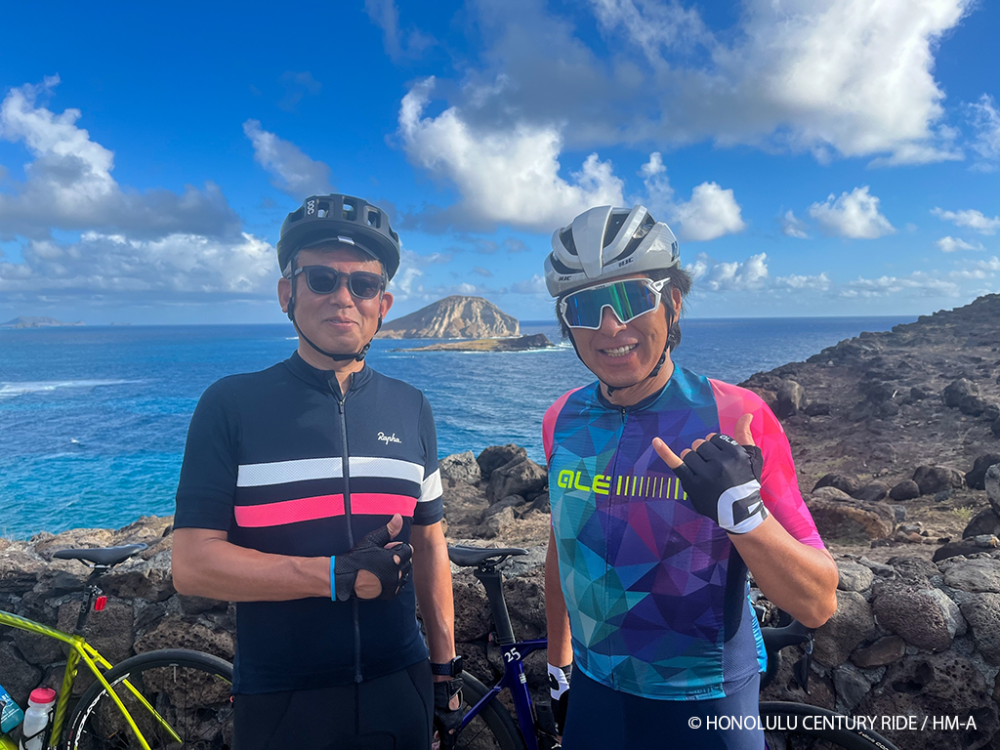
Beyond Makapuu Point, you soon leave the coastline and enter a jungle area. The road winds through a lush forest, which is why it’s known as the jungle area.
Up to this point, it had been a series of amazing views and encounters, like meeting Mr. Imanaka. Riding through the jungle area, I started to feel tired. I had barely covered 30km, and I was already tired. My rear was hurting, my legs felt heavy, and I began to worry. I thought, “If I continue like this, I might not make it to the end. I need to keep up with someone.” But when I looked up, the rider ahead was far away, and it would take some serious effort to catch up. Temperatures were rising, and I was starting to feel a bit dazed.
That’s when it happened.
A gentle, yet powerful assistance lifted me up from behind. My bike accelerated with a deep growl, and my speed shot up by about 10km/h in an instant.
“Ohhhh! What’s this, what’s this? This explosive assist!”
“It’s me, Mr. Kawase!”
To my surprise, it was none other than Mr. Imanaka riding alongside me.
“Well, in my athlete days, I used to do this a lot. To make sure we didn’t fall behind when we had to lift our socks or do something for the team.”
That was one powerful assist! It felt like being pushed by a giant’s finger from behind. Is this what pro-level leg power is like?
While riding alongside Mr. Imanaka, we chatted for a while. Regrettably, I didn’t take any photos at that moment. But thanks to this powerful assist, I quickly regained my energy. It’s true, just like in marathons, in sports, your mental strength plays a big role.
“Alright, I’ll go on ahead for a bit,” Mr. Imanaka said, and he accelerated rapidly.
I tried to keep up, but he left me in the dust. Thanks, Mr. Imanaka!
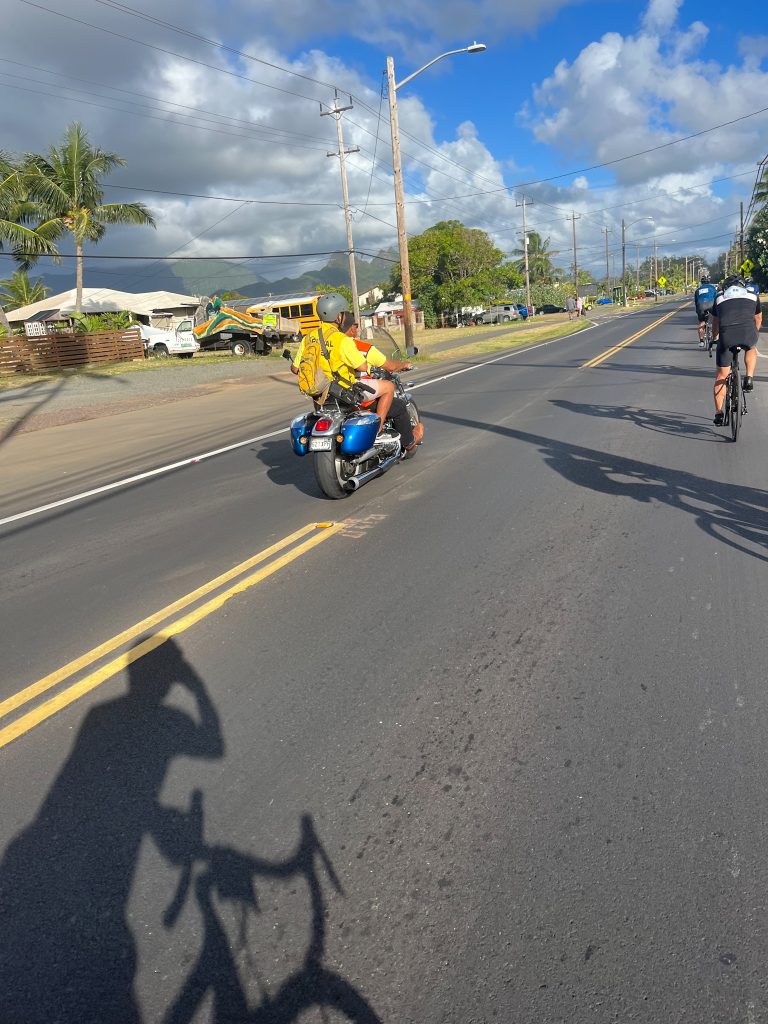
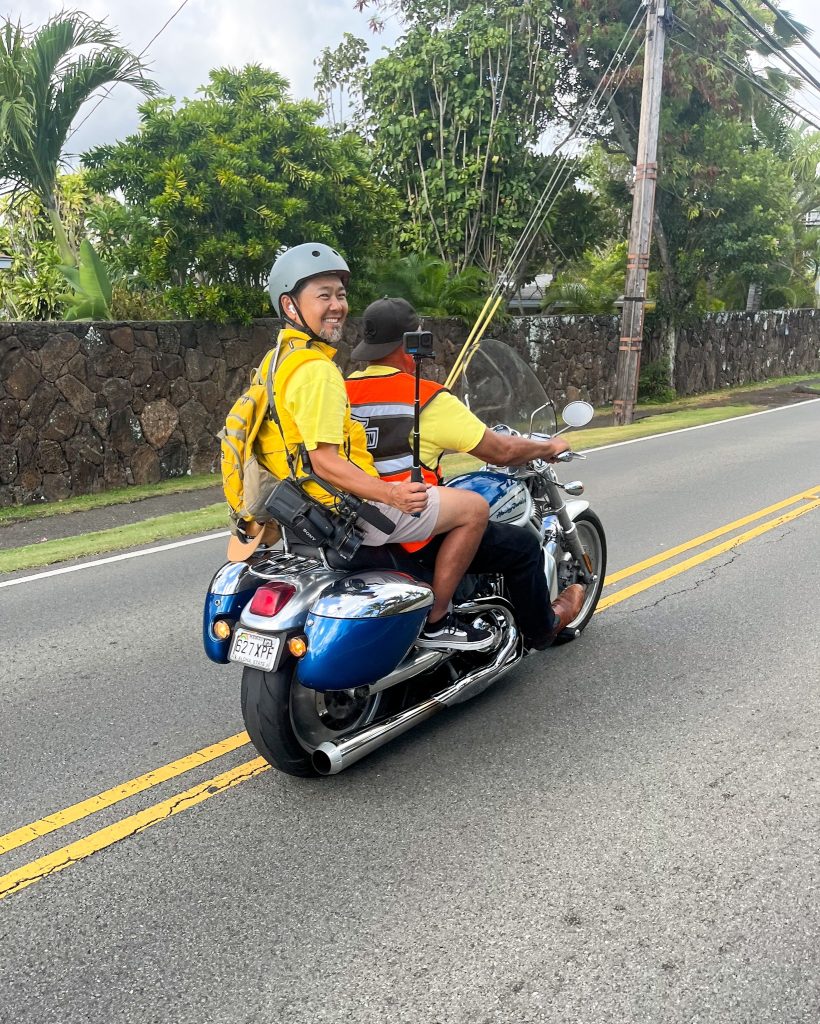
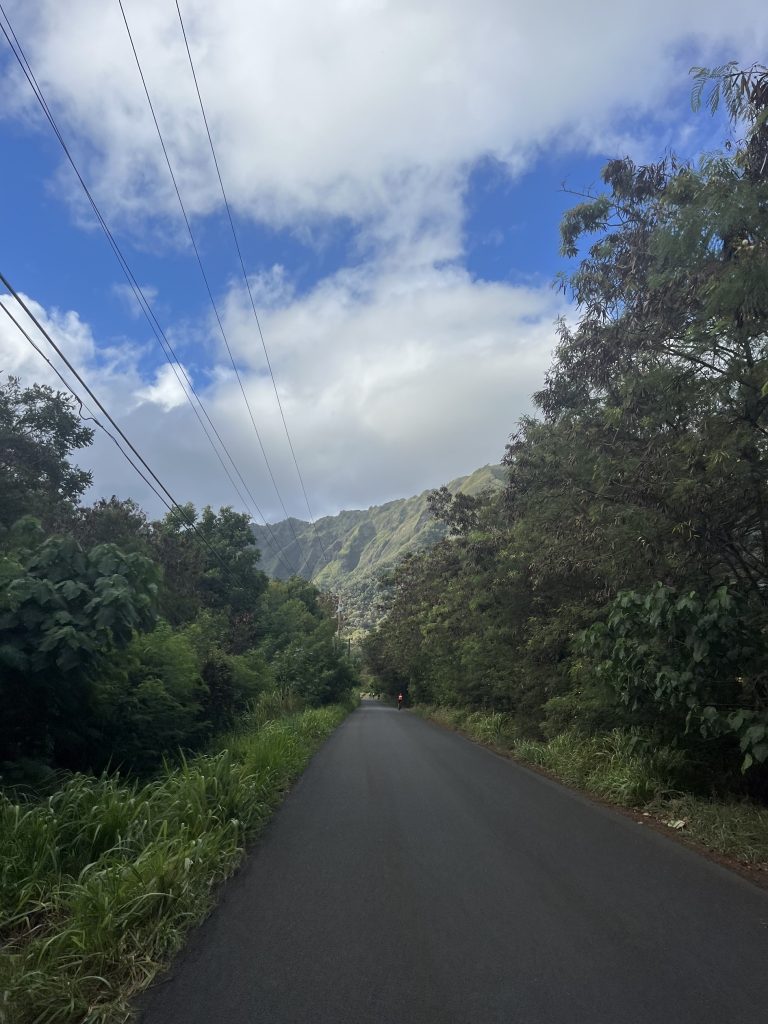
It was around 2 hours into the ride when I reached the second aid station at Kailua Intermediate School, covering about 40km, or a quarter of the total distance. Here, I discovered a delicious snack that resembled canapés: crackers spread with peanut butter and topped with bananas. This was a great find because it provided ample sugar and some salt, both of which I needed. I continued to enjoy these snacks at the upcoming aid stations.
However, I made a fatal mistake here.
I took the wrong exit and ended up turning back towards the starting point.
Some participants do turn around at this 40km point, and I mistakenly followed their route, riding back in the opposite direction. I started feeling something was off, but it took me about 30 minutes to realize my error and return the way I came. Kitagawa, the photographer, who had lost sight of me, hurriedly chased after me on his bike and shouted, “Kawase-san! You’re on the wrong course!” By the time I realized my mistake, I had already backtracked about 10km. I quickly made a U-turn and retraced my steps back to Kailua Intermediate School, putting me 20km behind where I should be.
Here, I noticed something else.
The HCR had cut-off points. To continue on the course, I needed to pass the next aid station by 10:30 am, or else the course would be closed, and I couldn’t proceed. Due to my relaxed pace in the first half, it was already 9:30 am at this point. I had about 20km to cover to reach the next aid station. If I continued at my sluggish pace, I risked missing the cut-off. I needed to pick up the pace—fast.
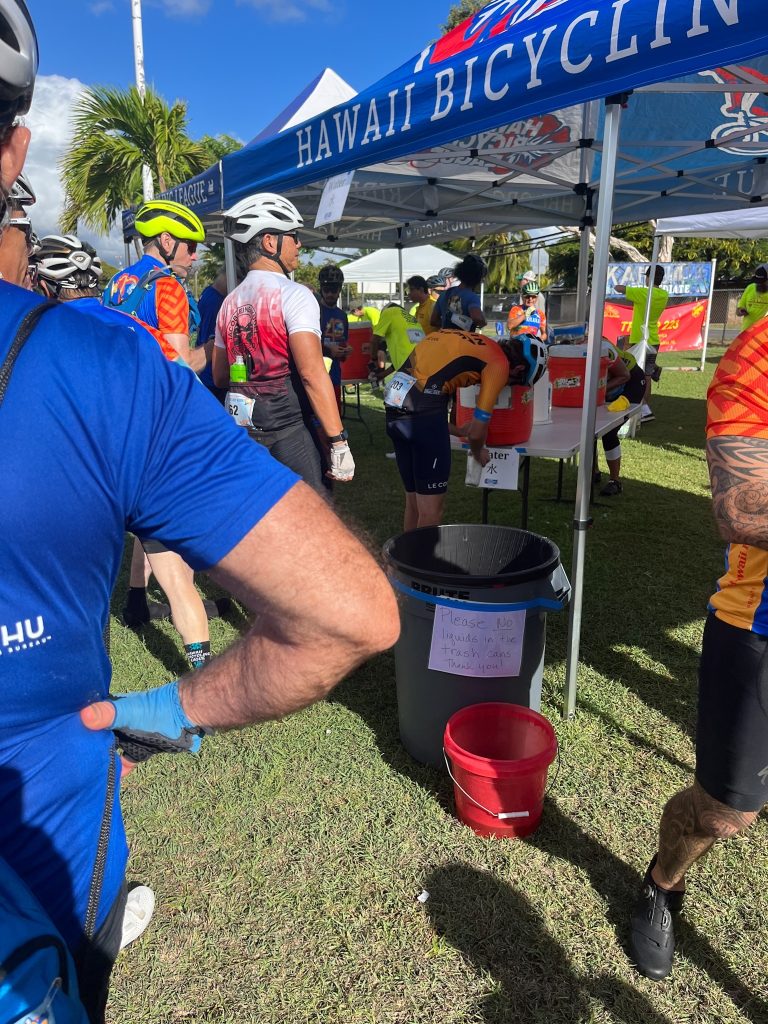
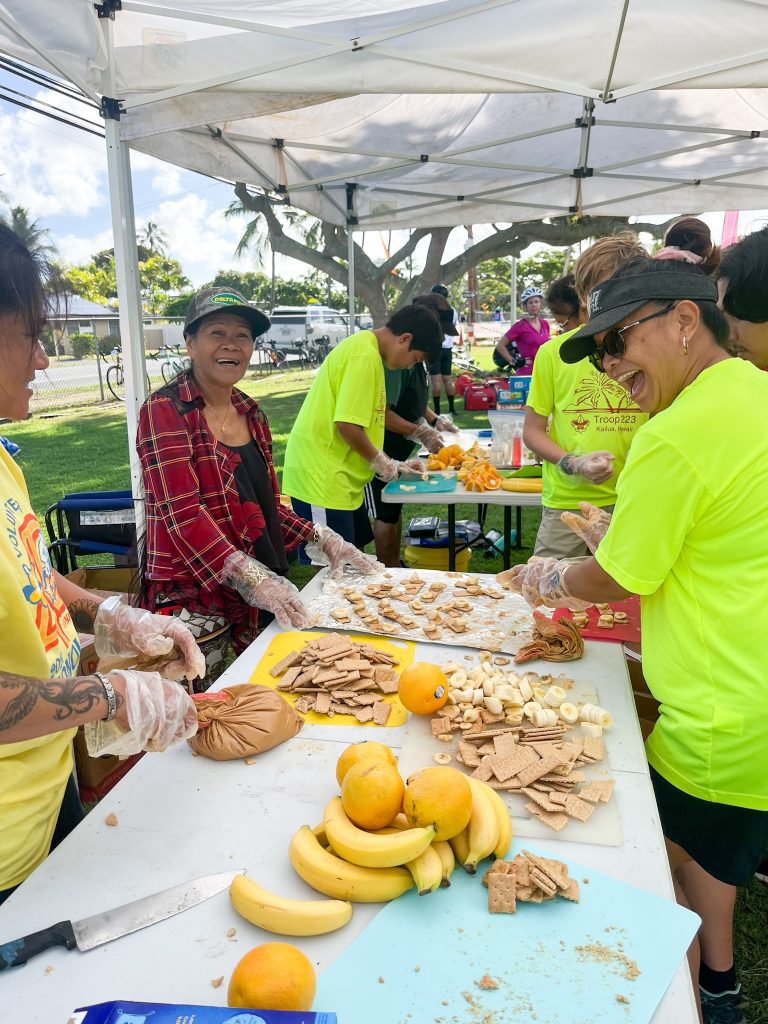
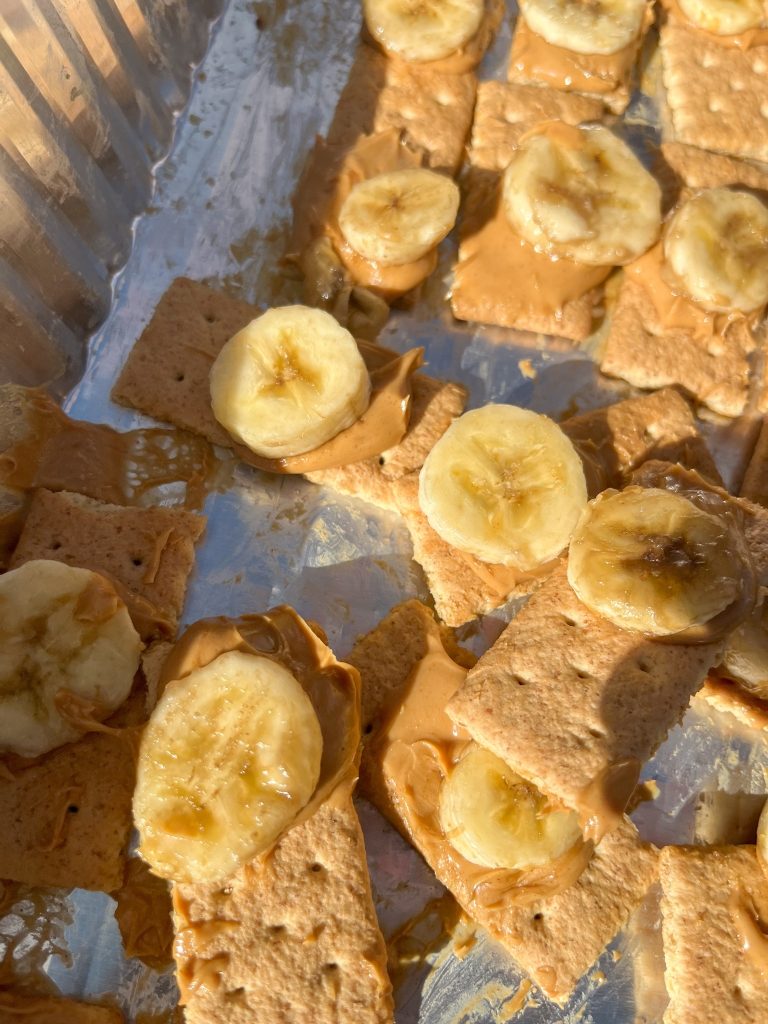
I pedaled relentlessly, with no time for taking pictures. All that mattered now was completing the ride. I couldn’t afford to let down the team that had invited me to this event or the film crew that was documenting it.
I was getting close to the cutoff time, around 15 minutes to spare. I pushed as hard as I could, striving to make it to the next aid station at Kahalu’u Beach Park. And I did it!
I arrived just in the nick of time.
Producer Watanabe approached me with a smile.
“Kawase-san, we were worried when you got lost, but you made it here much faster than expected. Well done! Ahead lies the ‘reward of breathtaking views.’
It’s the last 10 kilometers to the 100-mile turnaround point. This section is the most stunning of the HCR. You’ll get to ride along a road with the ocean right there, offering superbly scenic views. It’s truly exceptional. When I took a selfie, I couldn’t help but smile. Well, with such breathtaking beauty in front of you, who wouldn’t?”
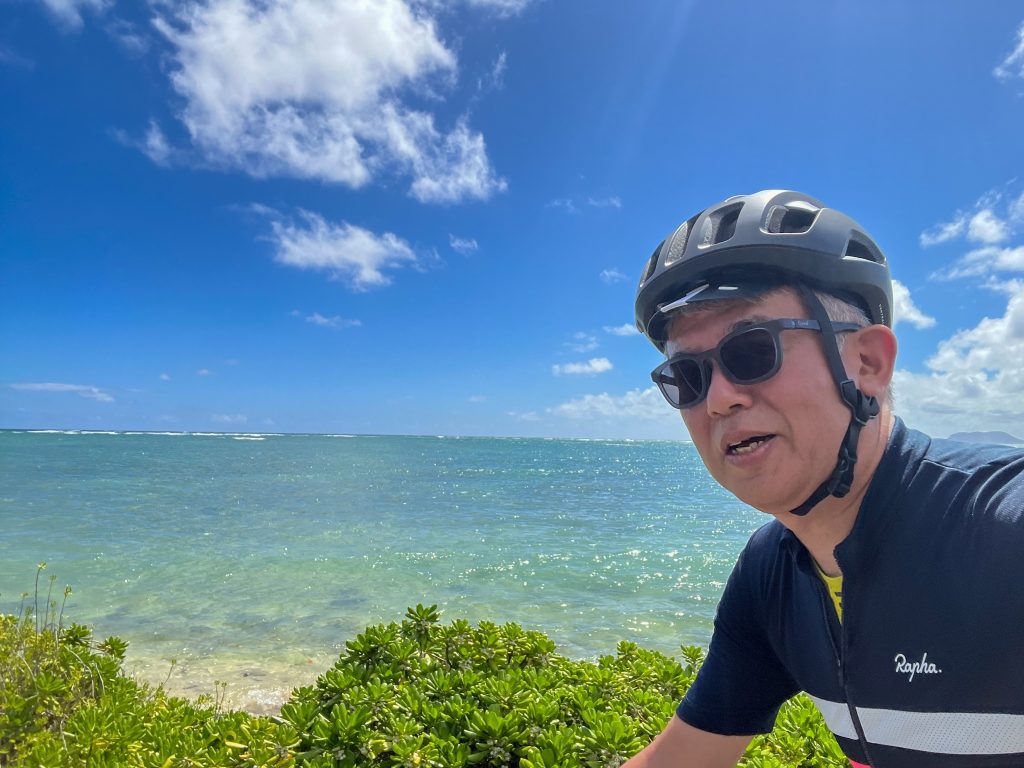
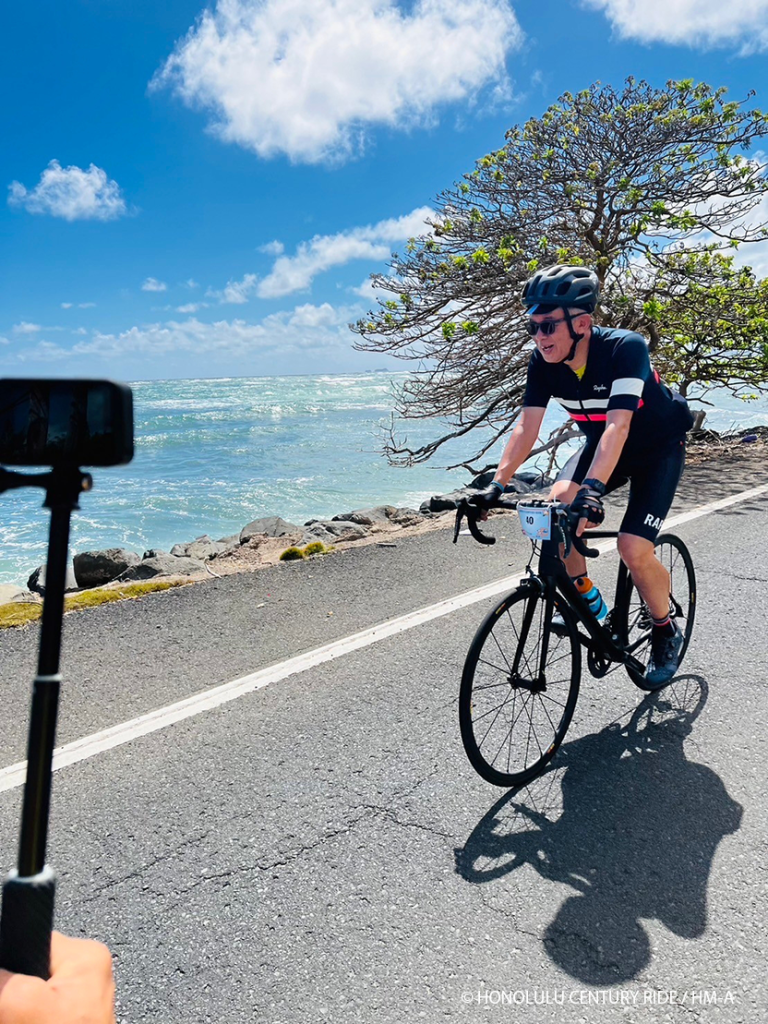
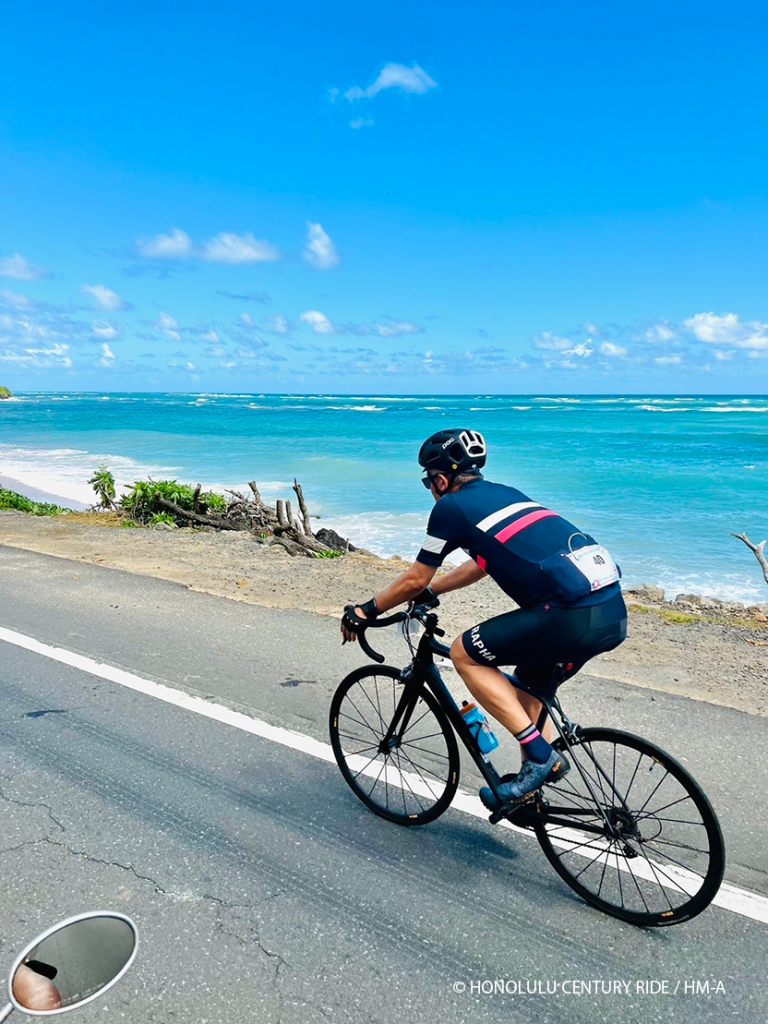
Just before noon, I arrived at the Swanzy Beach Park, the 100-mile turnaround aid station. That’s when Watanabe-san approached me.
“Would it be okay to do a brief interview here?” he asked.
“Of course,” I replied.
He continued, “I need a few minutes to set up the camera, so could we start in about five minutes?”
I found a bench nearby and sat down. Ah, a moment to rest was much needed. I had been riding almost non-stop to get here. There were still 80 kilometers to go. Regardless, it was a good idea to give my body a little break.
The wind coming from the sea was refreshing. I took off my shoes and lay down. Looking up, I saw big white clouds in the sky.
I couldn’t help but reflect on how I found myself in Hawaii at that moment due to various circumstances. Just like those clouds, which changed shape and flowed gently along, my life was evolving, moving forward step by step. Life is indeed a mysterious journey.

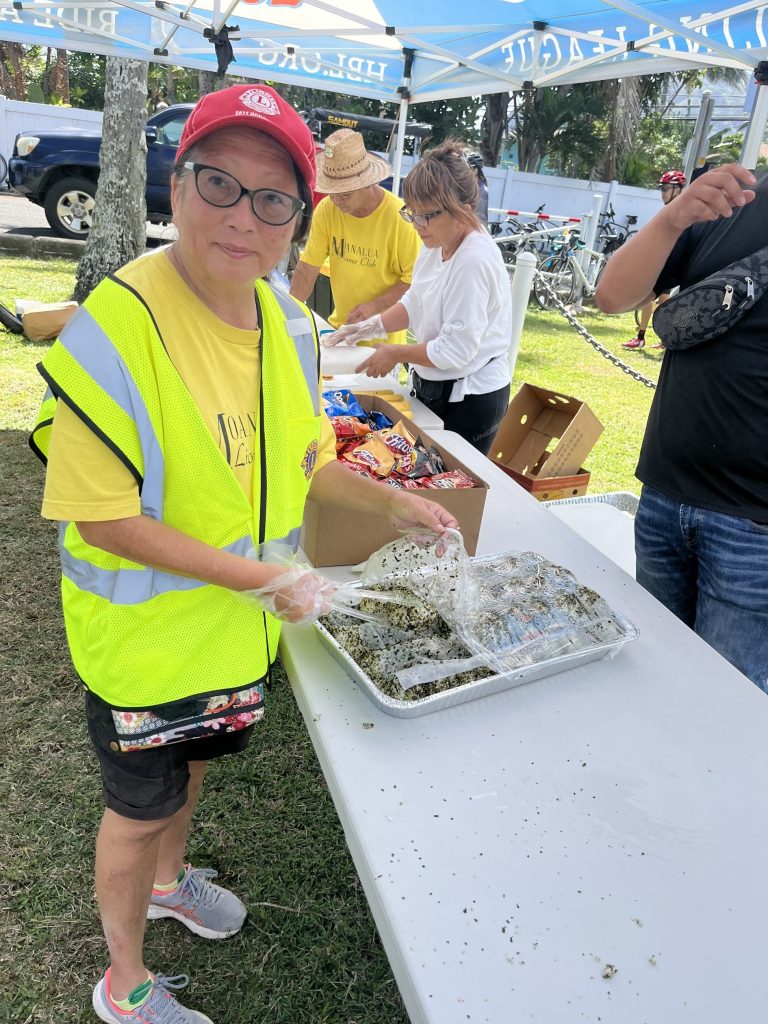
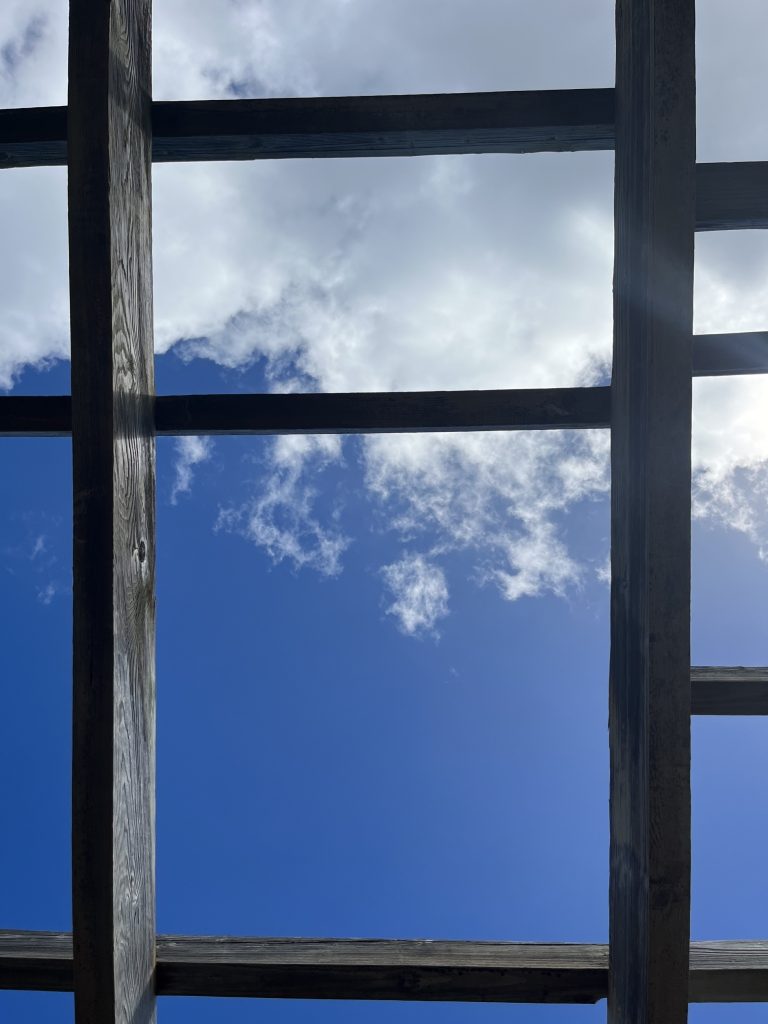
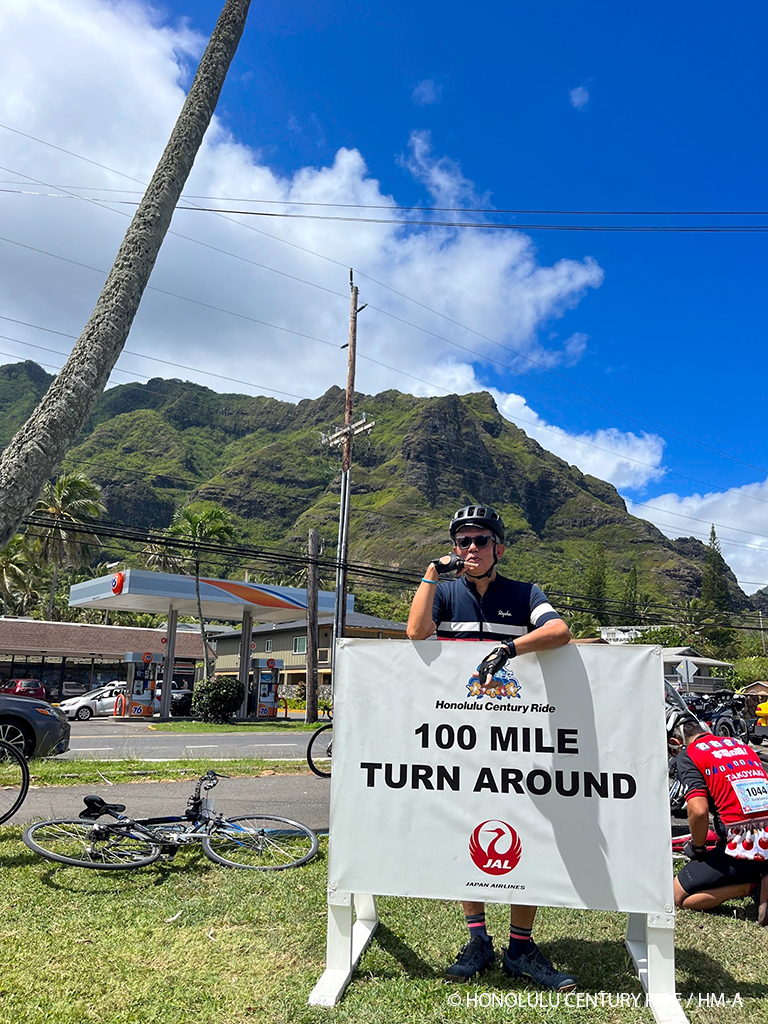
The ride back felt easier, maybe thanks to the tailwind.
I took very few breaks, simply kept my legs spinning.
As the afternoon rolled in, the temperature continued to rise.
At the aid stations, if I wanted, student volunteers would hose me down with water. My face and neck felt rough, covered in a crystallized layer of sweat and salt. For me, those student volunteers’ refreshing showers were heaven-sent.
From there, I continued pedaling silently, methodically, and relentlessly.
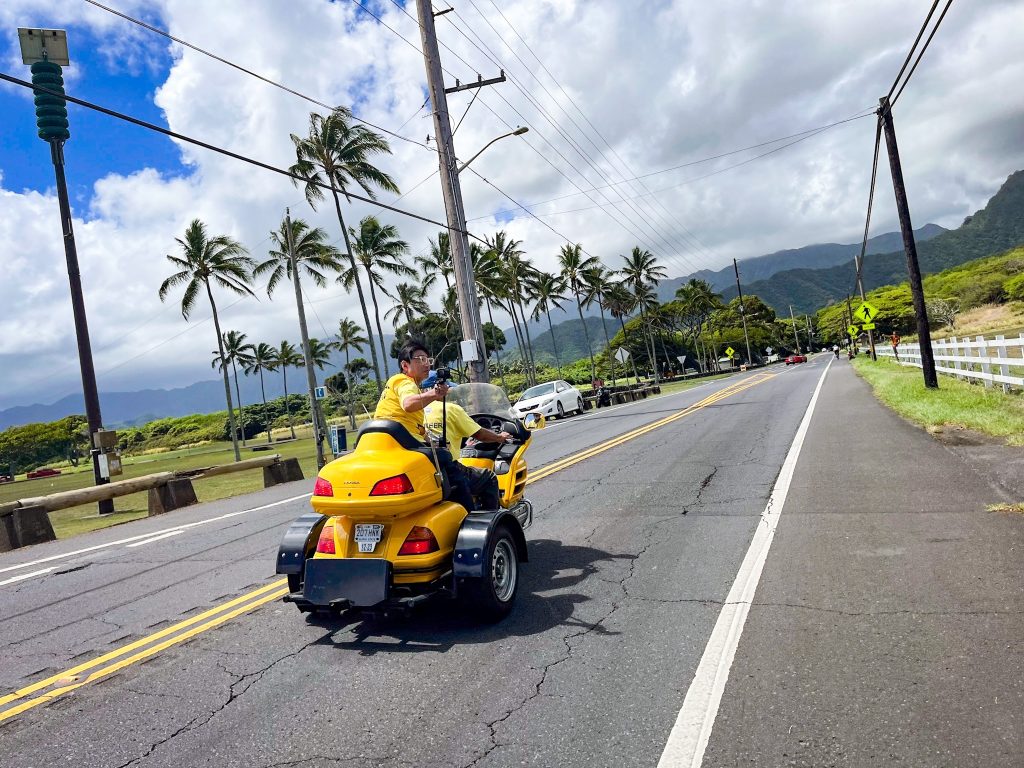
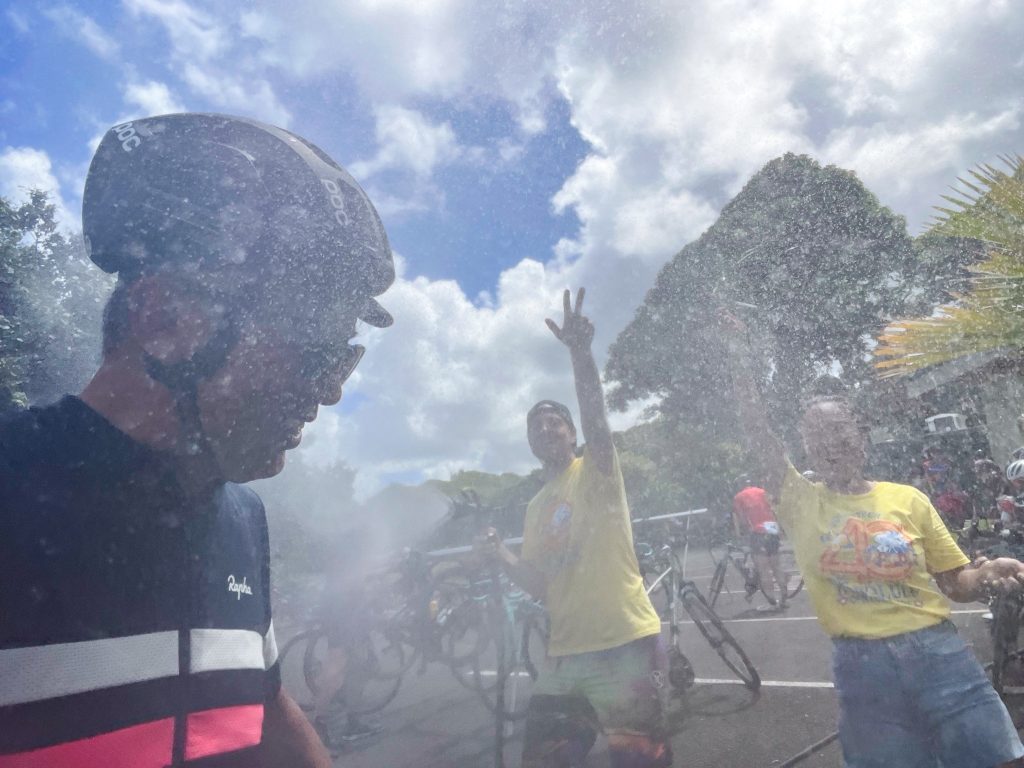
It’s during those last 20 kilometers or so that a particular feeling starts to emerge:
“Ah, it’s almost over.”
Indeed, this miraculous journey is about to reach its conclusion.
I’ve ridden along this long road, shared words with fellow riders, and complained about the afternoon heat with a lady from Guam. I discussed the difficulty of the climb at Makapuu Point with a tall man from the United States. A team from Vietnam helped me through a long stretch. And I had casual conversation with the legendary Imanaka-san. These fleeting connections during those moments in the saddle, each of them is precious.
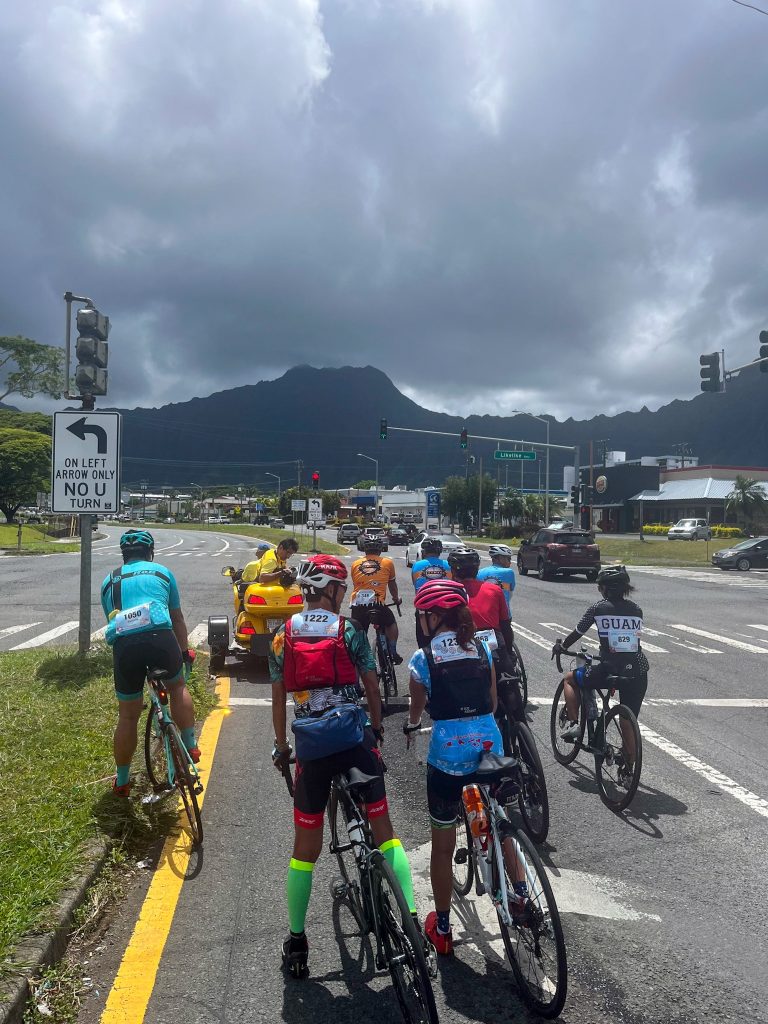
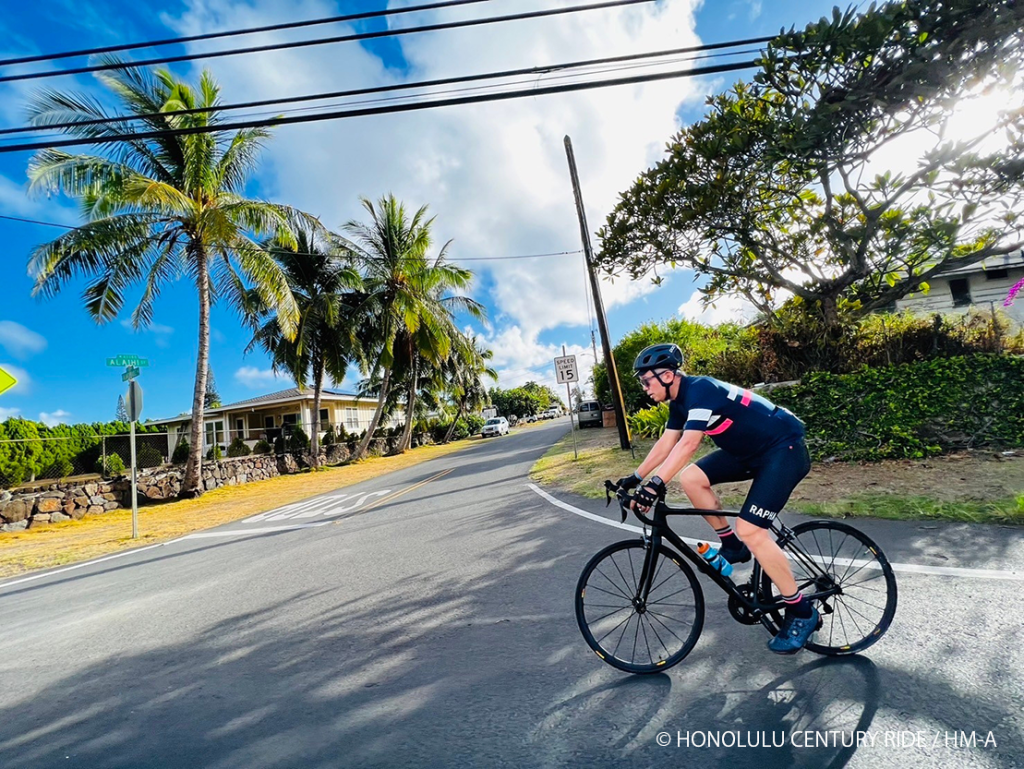
At the finish line, I was welcomed by producer Mr. Watanabe, the photographers Mr. Kitagawa, Mr. Ricardo, and the editor Ms. Kamura.
I felt a sudden release of tension.
Despite taking a wrong turn and losing quite a bit of time on the way, I managed to complete the ride. Many people congratulated me on the achievement. “Congratulations on finishing!” they cheered.
When I received my finisher’s certificate, emotions welled up inside me.
Mr. Watanabe mentioned he’d like to do an interview after the finish, and he needed about 10 minutes to set up. So, I had a bit of free time.
I took off my shoes, laid down on the grass, and let out a contented sigh. The Hawaiian breeze was pleasantly cooling on my overheated body. I looked up, and the trees swayed gently. If there’s such a thing as a pop-up shop in heaven, I thought, it must be this very moment.
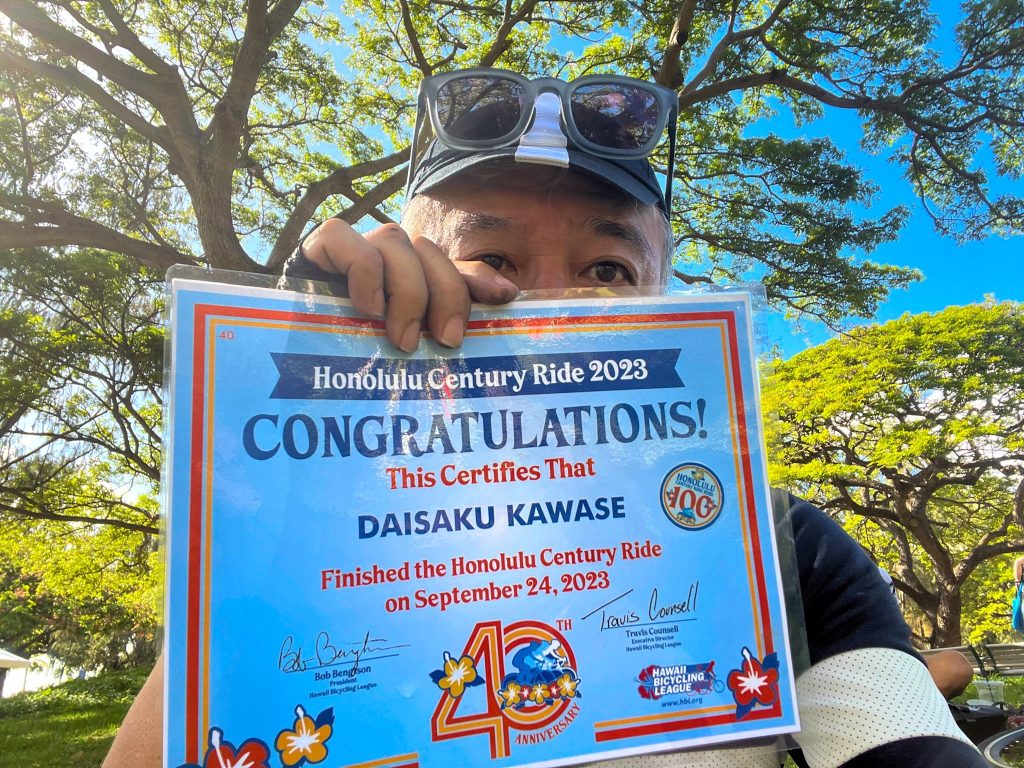
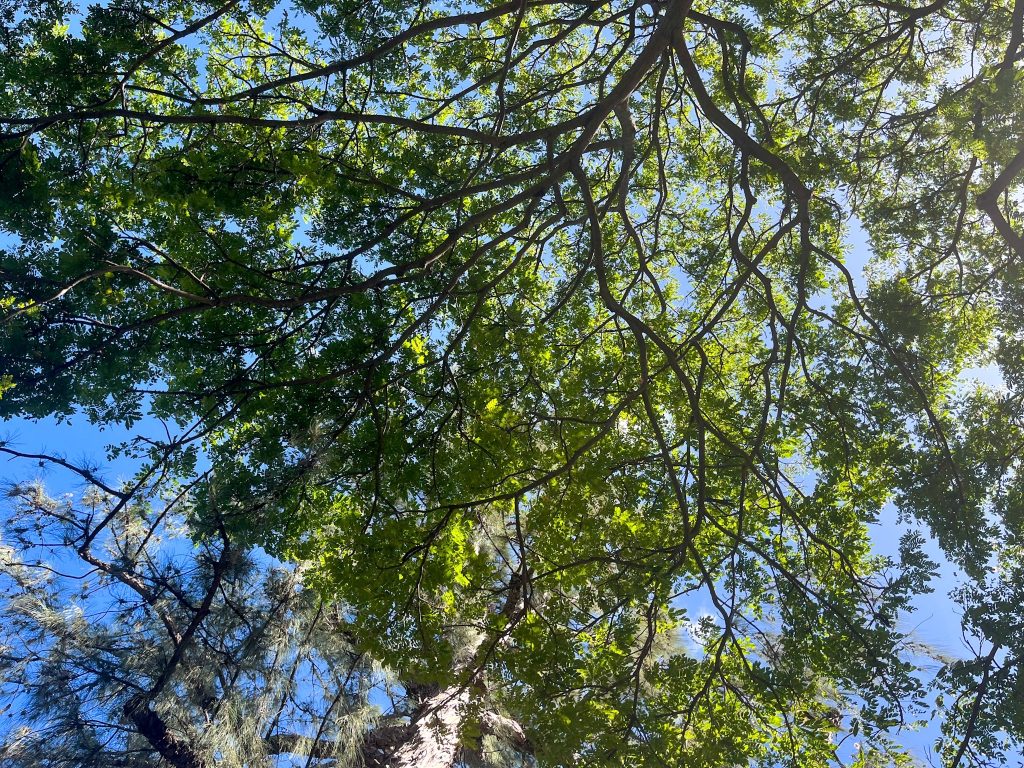
The next morning, I packed my belongings and began my journey back home.
This summer challenge at the age of 54 has come to an end. Traveling with my road bike always opens up new horizons in my world. This time, there were numerous encounters and moments of inspiration.
I’m sure I’ll set out on a journey again in the near future.
When that time comes, I would be delighted to meet you here once more. Thank you for reading till the end.
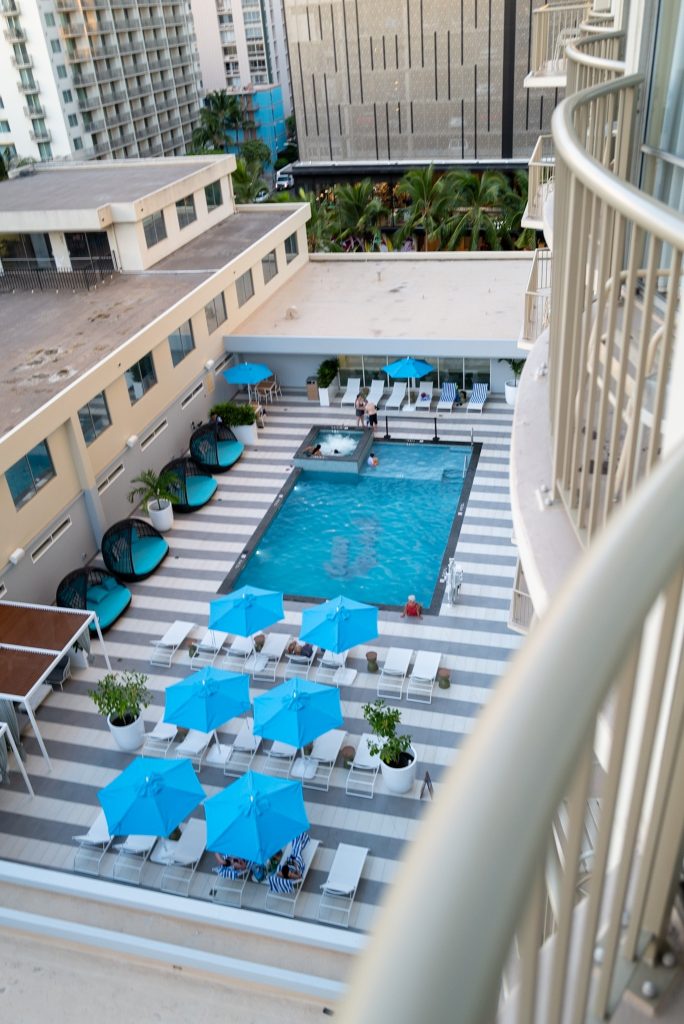
Text & Photo_Daisaku Kawase
🚴♂️Honolulu Century Ride 2023 Chronicle🚴♂️
#01 Bike transport: It’s Always a Dilemma (Part 1)
#02 Bike transport: It’s Always a Dilemma (Part 2)
#03 Hawaii was incredibly Hawaii
#04 First Hawaii Ride – Test Run Episode
#05 Ride! Honolulu Century Ride !
Profile
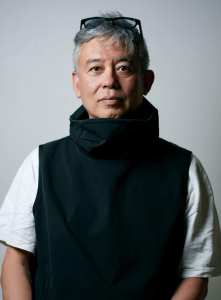
Daisaku Kawase
He is a Free Producer, the Representative of Days Co., Ltd. Born in Aichi Prefecture. With 16 years of road cycling experience, he loves scenic rides. He squeezes in rides between work and travels all over Japan with his bike. His beloved bike is a Trek. After working as a producer on programs like “Ariyoshi no Okane Hakken Totsugeki! Kaneo-kun,” “Oyasumi Japan Nemuiine,” and “Asaichi” at NHK, he became independent in 2022. In addition to producing programs, he also handles project production for government and corporate clients.